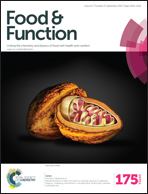Immobilized tannase treatment alters polyphenolic composition in teas and their potential anti-obesity and hypoglycemic activities in vitro†
Abstract
The aim of this work was to assess the effect of immobilized-tannase treatment on black, green, white and mate tea components and on their bioactivities relevant to obesity. Tannase treatment caused predictable changes in polyphenol composition with substantial reduction in galloylated catechins in green, white and black tea. Mate tea, which is rich in chlorogenic acids, was much less affected by tannase treatment although some degradation of caffeoyl quinic acid derivatives was noted. The original tea samples were effective in inhibiting digestive enzymes in vitro. They inhibited amylase activity, some with IC50 values ∼70 μg mL−1, but were much less effective against α-glucosidase. They also inhibited lipase activity in vitro and caused dose-dependent reductions in lipid accumulation in cultured adipocytes. The bio-transformed tea samples generally matched the effectiveness of the original samples but in some cases they were markedly improved. In particular, tannase treatment reduced the IC50 value for amylase inhibition for green tea and white tea by 15- and 6-fold respectively. In addition, the bio-transformed samples were more effective than the original samples in preventing lipid accumulation in adipocytes. These in vitro studies indicate that bio-transformed tea polyphenols could assist in the management of obesity through improvement in energy uptake and lipid metabolism and also indicate that biotechnological modification of natural food molecules can improve the benefits of a common beverage such as tea.

- This article is part of the themed collection: SBQ-RSC: Celebrating UK-Brazil collaborations

 Please wait while we load your content...
Please wait while we load your content...